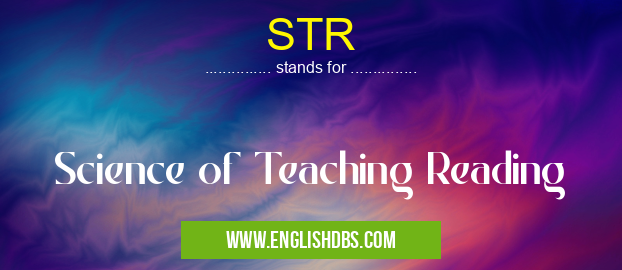What does STR mean in ACADEMIC & SCIENCE
STR stands for Science of Teaching Reading, a methodology used to teach students the skills and strategies necessary for effective reading. This approach emphasizes explicit instruction in phonics, phonemic awareness, fluency, vocabulary, and comprehension. It is grounded in scientific research and has been shown to improve reading outcomes for students of all ages.

STR meaning in Academic & Science in Academic & Science
STR mostly used in an acronym Academic & Science in Category Academic & Science that means Science of Teaching Reading
Shorthand: STR,
Full Form: Science of Teaching Reading
For more information of "Science of Teaching Reading", see the section below.
STR Meaning in Science
In the field of science, STR represents the Science of Teaching Reading, which is a research-based approach that focuses on teaching students the foundational skills of reading. This includes phonics, phonemic awareness, fluency, vocabulary, and comprehension.
STR Full Form
The full form of STR is Science of Teaching Reading. This methodology is based on the idea that reading is a skill that can be taught explicitly and systematically. It involves breaking down the reading process into smaller, more manageable components and teaching them one at a time.
What Does STR Stand For?
STR stands for Science of Teaching Reading. This approach to reading instruction is based on the idea that reading is a complex skill that can be broken down into smaller, more manageable components. These components include:
- Phonics: The relationship between letters and sounds
- Phonemic awareness: The ability to identify and manipulate individual sounds in words
- Fluency: The ability to read quickly and accurately
- Vocabulary: The knowledge of words and their meanings
- Comprehension: The ability to understand what is read
Essential Questions and Answers on Science of Teaching Reading in "SCIENCE»SCIENCE"
What is the Science of Teaching Reading (STR)?
STR is a comprehensive approach to teaching reading that emphasizes the systematic and explicit instruction of foundational skills. It is based on the latest research on how children learn to read and includes five essential components: phonemic awareness, phonics, fluency, vocabulary, and comprehension.
What are the benefits of using STR?
STR has been shown to improve reading outcomes for students of all ages and abilities. Studies have found that students who receive STR instruction are more likely to become proficient readers, have higher reading comprehension scores, and enjoy reading more.
How is STR different from traditional reading instruction?
STR is different from traditional reading instruction in several ways. First, it is more systematic and explicit. Second, it focuses on teaching foundational skills in a sequential order. Third, it uses a variety of multisensory activities to engage students and help them learn.
What are the essential components of STR?
The essential components of STR are:
- Phonemic awareness: The ability to identify and manipulate individual sounds in words.
- Phonics: The ability to decode words by sounding out their letters.
- Fluency: The ability to read words and sentences quickly and accurately.
- Vocabulary: The knowledge of words and their meanings.
- Comprehension: The ability to understand what one reads.
How can I learn more about STR?
There are a number of resources available to help you learn more about STR. You can find books, articles, and websites on the topic. You can also attend workshops and conferences on STR.
Final Words: STR is an effective approach to teaching reading that has been shown to improve reading outcomes for students of all ages. It is based on scientific research and provides students with the skills and strategies they need to become successful readers.
STR also stands for: |
|
| All stands for STR |
